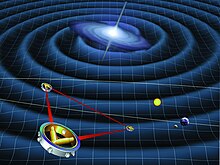Laser Interferometer Space Antenna

Artist's conception of LISA spacecraft
|
|
| Mission type | astrophysics |
|---|---|
| Operator | ESA |
| Website | www |
| Start of mission | |
| Launch date | 2030 (proposed) |
| Orbital parameters | |
| Reference system | Heliocentric |
| Semi-major axis | 1 AU |
| Period | 1 year |
| Epoch | planned |
The Laser Interferometer Space Antenna (LISA), is a proposed European Space Agency mission designed to detect and accurately measure gravitational waves — tiny ripples in the fabric of space-time — from astronomical sources. LISA would be the first dedicated space-based gravitational wave detector. It aims to measure gravitational waves directly by using laser interferometry. The LISA concept has a constellation of three spacecraft, arranged in an equilateral triangle with million-kilometre arms (2.5 million km) flying along an Earth-like heliocentric orbit. The distance between the satellites is precisely monitored to detect a passing gravitational wave.
The LISA project started out as a joint effort between the United States space agency NASA and the European Space Agency ESA. However, in 2011, NASA announced that it would be unable to continue its LISA partnership with the European Space Agency due to funding limitations. A scaled down design initially known as the New Gravitational-wave Observatory (NGO) was proposed for ESA's Cosmic Vision L1 mission selection. In 2013, ESA selected 'The Gravitational Universe'as the theme for its L3 mission in the early 2030s. whereby it committed to launch a space based gravitational wave observatory. In January 2017, LISA was proposed as the candidate mission.
A LISA-like mission is designed to directly observe gravitational waves, which are distortions of space-time travelling at the speed of light. Passing gravitational waves alternately squeeze and stretch objects by a tiny amount. Gravitational waves are caused by energetic events in the universe and, unlike any other radiation, can pass unhindered by intervening mass. Launching LISA will add a new sense to scientists' perception of the universe and enable them to listen to a world that is invisible in normal light.
...
Wikipedia
